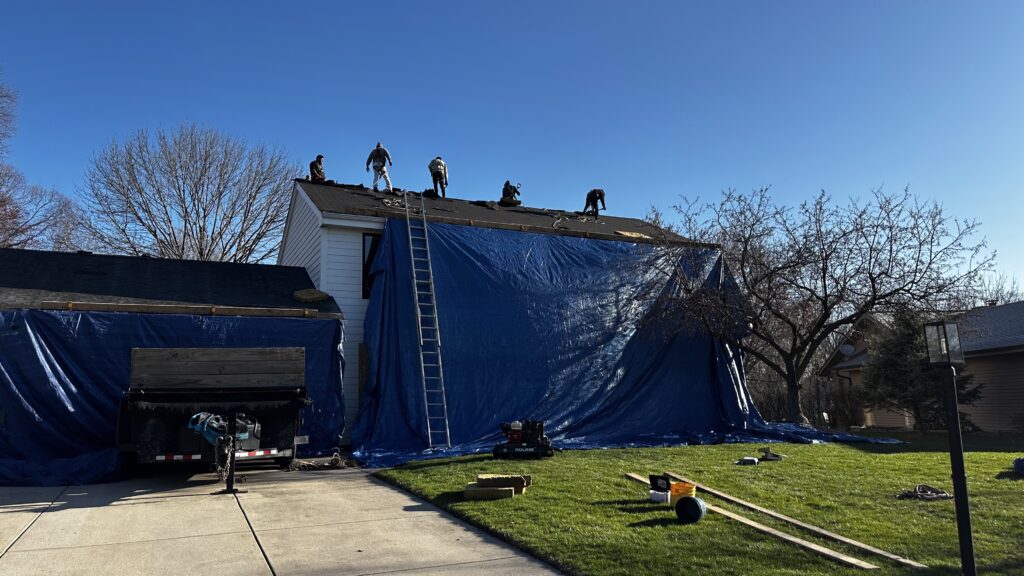The Top 3 Common Mistakes with DIY Roof Repairs
Receiving the news that you need a roof replacement can be devastating. It’s a big home improvement project to take on – mentally and financially.
Homeowners are often tempted to turn their roof replacements or repairs into DIY projects to avoid the cost of hiring a contractor. But while a DIY project might seem easy at first, there can be unexpected events that lead to problems down the road.
At Rescue My Roof, we understand buying a new roof can be stressful. And we’ve seen homeowners take on DIY projects they weren’t prepared for, causing more damage to their homes.
We have spent over a decade educating homeowners to avoid hassles like this, and we’re here to help you, too.
First, we’ll talk about the main issues we’ve seen with DIY roof repairs. Second, we’ll dive into options that may be better for your wallet and your roof.
DIY Roof Repairs to Avoid
When we take matters into our own hands, things can get messy.
If you’ve ever done a DIY project in your home, you may understand how challenging it can be. But for those who are inexperienced in the art of DIY, they may not know what lies ahead of them.
Here are some DIY projects we commonly see in the roofing industry that you should avoid.
1. Using Flex Seal to Repair Roof Leaks
When your roof is leaking, it may seem like an easy fix. Why hire a professional – which could cost hundreds of dollars – when you could do it yourself?
We’ve seen many homeowners attempt to fix roof leaks with spray sealants like Flex Seal. Unfortunately, this may not make all of the issues go away.
Even if you notice the water is no longer leaking into your home, the damage is already done. The excess moisture may have caused damage to the wooden decking or mold to begin to grow in your attic space.
Eventually, you will have to call an expert to fix these problems. And when you do, they will have to remove everything with a spray sealant on it from your roof to access the damaged decking.
The additional labor, disposal fees, and time it takes to fix the issues caused by the spray sealant can result in higher costs than what you would have paid initially.
Our advice: don’t use any sealants on your roof without a professional recommendation.
2. Using Caulk on Your Roof
Another way homeowners try to combat leaks, missing shingles, or damaged flashing is by caulking every crevice they can find.
While your roof may look like it’s put back together, this can lead to issues down the road.
When you are doing repairs on a roof experiencing these issues, it may mean that it’s time for a roof replacement. You are only putting bandaids on an injury that needs surgery.
When professionals come in to replace the roof, they will find that everything is stuck together and more difficult to remove. There will be added labor costs to fix the issues that could have been avoided if you called a professional in for an inspection before doing any DIY repairs.
3. Putting Tarps on Your Roof

Putting a tarp on your roof to prevent further water damage appears to be a harmless fix, right?
Wrong. Many homeowners use nails to secure the tarp to their roof. In doing so, they create more penetrations and more entry points for water and moisture.
The goal is to prevent your roof from damage, but you are only causing more damage in doing so.
If you notice a leak, the best course of action is to call a professional to diagnose it accurately and handle any necessary repairs.
Is Doing a DIY Repair Better or Less Expensive than Calling A Roofing Contractor?
Unless extensive research is done beforehand and you use contractor-approved methods, DIY repairs usually result in higher costs and worse results.
When you complete a DIY repair, the only cost you are saving money on is labor costs. However, there are additional tools and materials you may need to purchase that will add up over time.
If you are set on doing a DIY roof project and know the risks, it’s best to begin a spreadsheet of the products and tools you will need along with their cost.
Additionally, you can get free roof estimates from roofing contractors to see the price range. After doing your due diligence, compare your costs with the contractor’s estimate to determine whether or not you want to undertake a DIY roof project.
Can You Do a DIY Roof Repair?
Ultimately, this answer is up to you.
There is no right or wrong answer, only wrong techniques. If you improperly nail down a tarp or use a spray sealant on your roof – sure you completed a DIY repair – but you also caused more problems.
If you can do your research, talk to local contractors for an estimate, and the tools are in your budget, a DIY roof repair may be a suitable option for you.
Continue your DIY roof repair research with “The Top 7 Tools You’ll Need for Your DIY Roof Replacement” and “DIY Roof Replacement: 13 Tools You’ll Need to Get Started.”
If a DIY repair feels overwhelming, that’s okay. If you live in Southeastern Wisconsin, you can contact Rescue My Roof for all of your roof repair and replacement needs.


